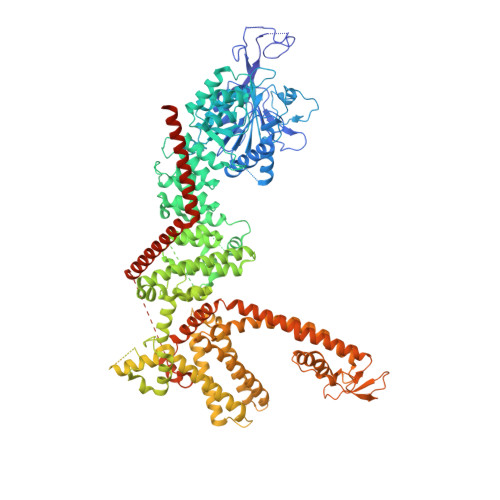Physiological temperature drives TRPM4 ligand recognition and gating.
Hu, J., Park, S.J., Walter, T., Orozco, I.J., O'Dea, G., Ye, X., Du, J., Lu, W.(2024) Nature
- PubMed: 38750366
- DOI: https://doi.org/10.1038/s41586-024-07436-7
- Primary Citation of Related Structures:
9B8W, 9B8X, 9B8Y, 9B8Z, 9B90, 9B91, 9B92, 9B93, 9B94 - PubMed Abstract:
Temperature profoundly affects macromolecular function, particularly in proteins with temperature sensitivity 1,2 . However, its impact is often overlooked in biophysical studies that are typically performed at non-physiological temperatures, potentially leading to inaccurate mechanistic and pharmacological insights. Here we demonstrate temperature-dependent changes in the structure and function of TRPM4, a temperature-sensitive Ca 2+ -activated ion channel 3-7 . By studying TRPM4 prepared at physiological temperature using single-particle cryo-electron microscopy, we identified a 'warm' conformation that is distinct from those observed at lower temperatures. This conformation is driven by a temperature-dependent Ca 2+ -binding site in the intracellular domain, and is essential for TRPM4 function in physiological contexts. We demonstrated that ligands, exemplified by decavanadate (a positive modulator) 8 and ATP (an inhibitor) 9 , bind to different locations of TRPM4 at physiological temperatures than at lower temperatures 10,11 , and that these sites have bona fide functional relevance. We elucidated the TRPM4 gating mechanism by capturing structural snapshots of its different functional states at physiological temperatures, revealing the channel opening that is not observed at lower temperatures. Our study provides an example of temperature-dependent ligand recognition and modulation of an ion channel, underscoring the importance of studying macromolecules at physiological temperatures. It also provides a potential molecular framework for deciphering how thermosensitive TRPM channels perceive temperature changes.
Organizational Affiliation:
Van Andel Institute, Grand Rapids, MI, USA.
















